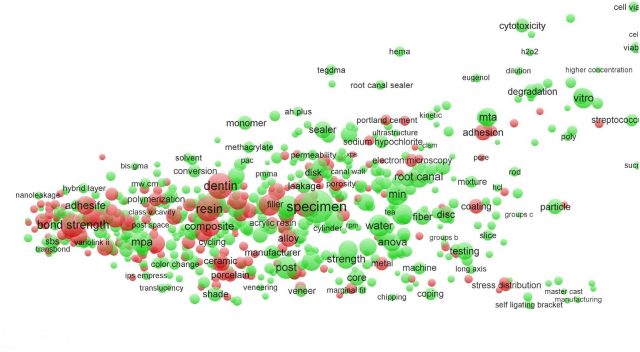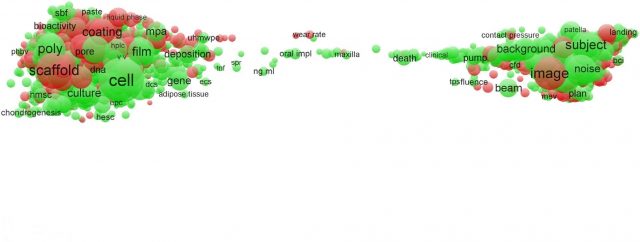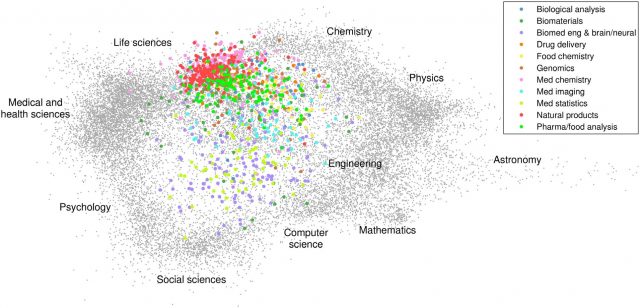Mapping interdisciplinarity
Some decades ago, the American social scientist Donald T. Campbell imagined interdisciplinary research as a fish-scale structure according to which scholars should make an effort to create links between disciplines, spanning areas ignored by others, in an overlapping pattern aiming to cover the entire web of knowledge. He suggested that scholars should overcome the “ethnocentrism of disciplines” and take the risk of approaching new fields, for example by, once in a while, subscribing to scientific journals or congresses not directly related to their disciplines. He aimed to achieve “collective comprehensiveness through overlapping patterns of unique narrowness”. 1
Nowadays, interdisciplinary research is often praised among scientific and political institutions for being a source of creativity, generating new research paths and challenging established beliefs by bringing together contributions from many different perspectives. Moreover, tackling problems from different approaches is considered by many the best way to respond to complex social needs, which are, in the end, the most important purpose of scientific research. At this point, the question arises whether all these positive considerations about interdisciplinary research are leading to real outcomes, and if so, what else can be done to encourage interdisciplinarity among sciences.
As a good example of how to assess the outcomes of interdisciplinary research between different fields in science, a recent study explores the impact that the engineering and physical sciences (EPS) have had on the health and life sciences (HLS) in the last couple of decades by using bibliometric methods2. They look into those studies at the boundaries of these disciplines, wherever the outputs of one field have been used as the inputs of another. By doing this, they have found the areas in which interdisciplinarity was key to achieve the latest scientific developments.
The study uses two complementary approaches to assessing interdisciplinarity between these two broad areas of knowledge, one based on term maps and the other based on citations relations. The use of term maps in order to visualize structures and dynamics in science is widespread and it is a great tool to get an overview of a specific subject at a glance. They analyze up to 2000 different terms for each specific research field; then, determine the number of publications in which each pair of terms from different disciplines co-occur in individual titles or abstracts, obtaining a matrix of term co-occurrence. The resulting term map shows a location for each term in a 2D space. Each bubble represents a different term, being the most important attributes the size of the bubble, accounting for the frequency that term is cited, and the distance between bubbles, accounting for the closeness of terms.

Interestingly, the results of this analysis for different fields and subfields of health and life sciences lead to a general conclusion: most of the EPS-related terms are found in the areas of cell and tissue engineering and biomaterials. In particular, they found that materials science is the most interacting field overlapping with life sciences nowadays. This is the case, for instance, in the field of dentistry, with EPS-related terms such as adhesion, alloy, bond strength, cement, ceramic, coating, composite, metal… most of them used in high impact research.
The biomedical engineering field is also strongly EPS-driven. In this case, we can observe the other big EPS-related area in life sciences, imaging technology. In fact, the term map for this field is remarkably polarized, with two separate groups of terms, one related to material science and one to imaging techniques. Many of the EPS-related terms concern physics, chemistry and engineering research with a very high impact in the field. This is the case for research on nanoparticles and nanocomposites, and particularly on electrospinning and quantum dots, all of them cutting-edge research fields at the moment.

As a general observation, the study concludes that most of the high impact EPS-related research in the health and life sciences often concerns: new materials and their properties, chemical methods, imaging technologies, medical engineering and new mathematical and statistical methods.
In the second part of the study, based on citations relations, and considering up to 10 million of publications covering all scientific disciplines, the researchers manage to group closely connected publications together into clusters, obtaining more than 22000 research topics. They consider that those topics sharing a significant amount of citations both in the field of engineering and physical sciences (EPS), and in the health and life sciences (HLS) can be considered at the EPS-HLS interface. Then, narrowing down this number into a few broad research themes, the researchers find 11 big groups at the edge of EPS-HLS interface: biological analysis, biomaterials, biomedical engineering, drug delivery, food chemistry, genomics, medical chemistry, medical imaging, medical statistics, natural products and pharmacological and food analysis.

It seems then pretty clear that the advances in the health and life sciences are highly dependent on research in the engineering and physical sciences, and also that most of the high impact research is the result of this overlapping. Oddly enough, however, the study points out that this fruitful synergy has not led to an increase in the percentage of publications at the EPS-HLS interface in the last few years.
The answer to this contradiction might well be the imbalance in the allocation of research funds observed during the last couple of decades. According to Stephen Merrill3, director of the National Academies’ Board on Science, Technology, and Economic Policy in the USA, in the last twenty years the research investments in physics, chemistry, mathematics and engineering have declined 20%, while health and life sciences have experienced an increase of 20% in the same period in the USA. Furthermore, he claims that most of the investment in the physical and engineering sciences is allocated in military budgets, rather than civilian institutions. How could the health and life sciences take advantage of the benefits of interdisciplinary research if the development of physical and engineering sciences is not equally promoted?
Contrary to what one might think, however, it could be that this imbalance in the allocation of funds is rather a consequence than the cause of the troubles experienced by interdisciplinary research. A very interesting article4 shows how most of the evaluations carried out by political institutions in order to allocate research funds are driven by journal rankings. These rankings have been probed systematically biased in favour of mono-disciplinary research. In fact, interdisciplinary research is often considered of “dubious quality” by peers and reviewers, making it really difficult to publish in prestigious journals. There is an urgent need for more reliable and plural indicators than citation impact in order to assess research excellence or the value of this research to solve real-world issues. Otherwise, the chances are that science developments are at risk of becoming irrelevant to their main purpose of achieving important social outcomes.
References
- Campbell, Donald T. “Ethnocentrism of disciplines and the fish-scale model of omniscience.” Interdisciplinary relationships in the social sciences 328 (1969) 348. ↩
- Waltman L, van Raan AFJ, Smart S. Exploring the Relationship between the Engineering and Physical Sciences and the Health and Life Sciences by Advanced Bibliometric Methods. PLoS ONE 9(10): e111530 (2014). doi:10.1371/journal.pone.0111530. ↩
- Merrill, Stephen A. “Real Numbers: A Perpetual Imbalance?” Issues in Science and Technology 29, no. 2 (2013) ↩
- Rafols I., Leydesdorff L., O’Hare A., Nightingale P., Stirling A., How journal rankings can suppress interdisciplinary research: A comparison between innovation Studies and Business & Management. Research Policy 41 (2012) 1262. doi: 10.1016/j.respol.2012.03.015 ↩